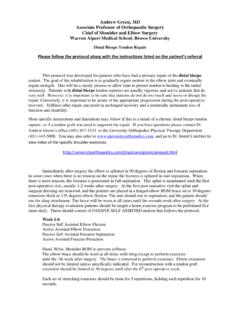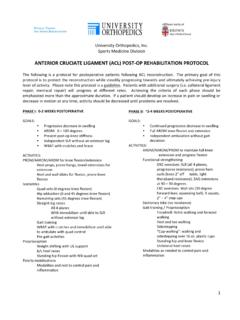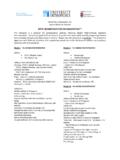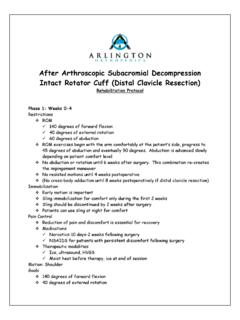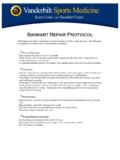Transcription of Reverse Total Shoulder Replacement Post Op rehab
1 Reverse Total Shoulder Replacement post -Operative RehabilitationThis protocol was developed for patients who have undergone a Reverse Total Shoulder Replacement . Reverse Total Shoulder Replacement is performed for a variety of indications. The most common indications are rotator cuff tear arthropathy (glenohumeral arthritis and massive unrepairable rotator cuff tear), massive unrepairable rotator cuff tear without arthritis, and revision Shoulder Replacement . The common theme is that these patients do not have a functioning rotator cuff and that their functional outcome is highly dependent upon the deltoid goal of this protocol is to slowly advance range of motion and strength while avoiding dislocation of the Shoulder Replacement . Many patients with Reverse Total Shoulder replacements can elevate their arm above Shoulder level. However, unlike a typical Total Shoulder Replacement these patients tend to have limited active external rotation and have difficulty reaching behind their back.
2 Over aggressive efforts to improve rotational motion might cause the Replacement to dislocate or lead to implant contact the physical therapy department at (401) 457-1590 if there are any questions. You may also refer to and go to Dr. Green s section to see the exercise video. The dressing is removed three days after surgery. Leave the steri-strips on the incisions until one week after your surgery. After the dressing is removed you may shower quickly and gently pat your Shoulder dry with a clean towel. When in the shower you are to wear a sling to protect your Shoulder from injury. If there is any drainage or concern about the healing of the incisions do not shower and just gently clean the surface of the Shoulder with rubbing 1-6: - Pendulum circumduction exercises-elbow flexion/extension motion exercises-wrist/hand and finger motion-Begin postural exercises with rhomboid and trapezius contraction-Neck range of motion to prevent cervical spine sorenessBegin light deltoid isometrics with elbow at the side during week otherwise indicated in the post -operative therapy referral the sling should be worn at all times except to perform home exercises five times per day.
3 Discontinue use of the sling at the end of week 5 and begin light active Green, MDAssociate Professor of Orthopaedic SurgeryChief of Shoulder and Elbow SurgeryWarren Alpert Medical School, Brown University1 Week 7: -Pulleys for assisted elevation to begin gentle strengthening and elevation patterning-Begin passive self assisted range of motion stretching exercises in supine forward elevation, supine or seated external rotation, internal rotation behind the back-Active range of motion exercises-Begin active elevation in the supine position to minimize gravity affect-Isometrics deltoid, internal rotation, external rotation-Supine deltoid exercises-Scapula stabilizationWeeks 12:-Theraband strengthening deltoid, internal rotation, external rotation-Continue passive self assisted stretching to achieve full range of motion End Result:It can take up to 12 months (1 year) to achieve the final result of a Reverse Total Shoulder Replacement . Most patients are very comfortable and functional after 3 :No UBE exercisesNo abduction stretching or strengthening .
4 Elevation motion and strengthening is to be performed in the scapular stiffness develops, strengthening is to be delayedHeat can be used after 2 weeks post -op to warm up prior to stretchingIce is used for pain control and after stretchingAndrew Green, MDAssociate Professor of Orthopaedic SurgeryChief of Shoulder and Elbow SurgeryWarren Alpert Medical School, Brown University2




